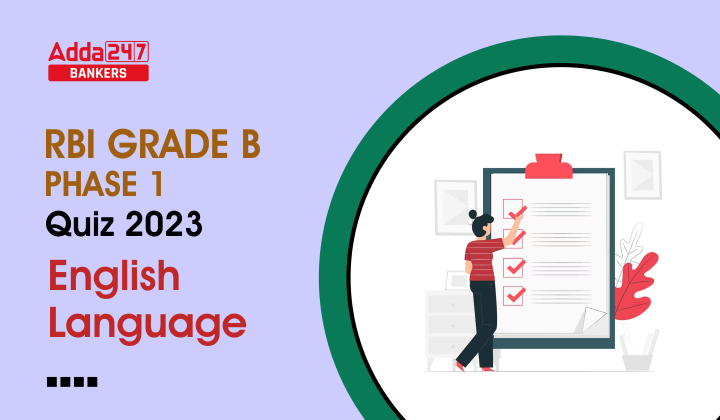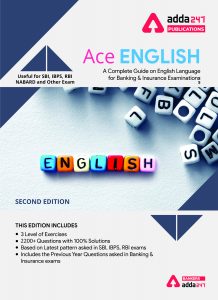Directions (1-10): In each of the question given below, a statement has been given with a blank. Some words or phrases have been given in the options following the statement. Choose the most appropriate word or phrase that could fit in the statement to make it contextually meaningful and grammatically correct.
Q1. Amazon.com is now publicly ______ several products that have been returned frequently by past buyers.
(a) convalescing
(b) recovering
(c) strapping
(d) recuperating
(e) flagging
Q2. The product warning could ______ alert customers to sell promoting items which may not be genuine, good-quality, accurate, or durable.
(a) improbably
(b) potentially
(c) unlikely
(d) unthinkably
(e) implausibly
Q3. Thalassemia is a genetic-blood disorder that requires people to have regular blood _______ mostly throughout the span of their life.
(a) stabilization
(b) activation
(c) inactivity
(d) transfusions
(e) sink
Q4. The technical equipment used by the security forces to ¬¬¬¬¬_______ IEDs has its limitations.
(a) ignore
(b) conceal
(c) detect
(d) suppress
(e) neglect
Q5. India is facing a water crisis with groundwater _______ and biodiversity loss, and climate change increasing the frequency of floods and droughts.
(a) decline
(b) upgrade
(c) strength
(d) betterment
(e) ascent
Q6. Centre for Cultural Resources and Training (CCRT) has carved a _____ among connoisseurs as a multidisciplinary space promoting music and dance events.
(a) closure
(b) niche
(c) solid
(d) banish
(e) supplant
Q7. India is well-positioned to play a leading role in shaping the ______ around Buddhist issues on the global stage.
(a) praise
(b) injure
(c) disregard
(d) approve
(e) discourse
Q8. The government’s inability to address the issue of rising inflation has created a sense of ________ among the general public.
(a) trust
(b) confidence
(c) optimism
(d) pessimism
(e) enthusiasm
Q9. The government’s efforts to ________ the use of renewable energy sources have been widely appreciated.
(a) limit
(b) encourage
(c) hamper
(d) discourage
(e) nullify
Q10. The new policy aims to _______ the use of plastic bags in the city in order to reduce environmental pollution.
(a) promote
(b) encourage
(c) ban
(d) facilitate
(e) subsidize
Solutions
S1. Ans. (e)
Sol. The most appropriate word that fits in the blank to make the sentence contextually meaningful and grammatically correct is “flagging”. The word “flagging” fits well in the context of the sentence as it means to mark something for attention or identification. The sentence talks about Amazon.com publicly marking or identifying certain products that have been frequently returned by past buyers.
Option (a) convalescing is an incorrect option as it refers to recover gradually from an illness or injury., which does not fit the context of the sentence.
Option (b) recovering is an incorrect option as it refers to get back to a normal state after an illness, injury, or setback, which does not fit the context of the sentence.
Option (c) strapping is an incorrect option as it refers to tie something securely with a strap or a band, which does not fit the context of the sentence.
Option (d) recuperating is an incorrect option as it refers to recover from an illness or injury, which does not fit the context of the sentence.
S2. Ans. (b)
Sol. The most appropriate word that fits in the blank to make the sentence contextually meaningful and grammatically correct is “potentially”. The word “potentially” fits well in the context of the sentence as it means possibly or with the potential to happen. The sentence talks about a product warning alerting customers about selling items that may not be genuine, good-quality, accurate, or durable.
Option (a) improbably is an incorrect option as it refers to not likely to happen or be true, which does not fit the context of the sentence.
Option (c) unlikely is an incorrect option as it refers to not likely to happen or be true, which does not fit the context of the sentence.
Option (d) unthinkably is an incorrect option as it refers to not capable of being imagined or believed, which does not fit the context of the sentence.
Option (e) implausibly is an incorrect option as it refers to not seeming reasonable or probable., which does not fit the context of the sentence.
S3. Ans. (d)
Sol. The most appropriate word that fits in the blank to make the sentence contextually meaningful and grammatically correct is “transfusions”. The word “transfusions” fits well in the context of the sentence as it means the process of transferring blood from one person to another. The sentence talks about thalassemia, a genetic-blood disorder that requires people to have regular blood transfusions mostly throughout the span of their life.
Option (a) stabilization is an incorrect option as it refers to the process of making something stable or keeping it from changing, which does not fit the context of the sentence.
Option (b) activation is an incorrect option as it refers to the process of starting or making something active, which does not fit the context of the sentence.
Option (c) inactivity is an incorrect option as it refers to the state of being inactive or not active, which does not fit the context of the sentence.
Option (e) sink is an incorrect option as it refers to go down or cause something to go down, which does not fit the context of the sentence.
S4. Ans. (c)
Sol. The most appropriate word that fits in the blank to make the sentence contextually meaningful and grammatically correct is “detect”. The word “detect” fits well in the context of the sentence as it means to discover or identify something. The sentence talks about the technical equipment used by the security forces to detect improvised explosive devices (IEDs).
Option (a) ignore is an incorrect option as it refers to pay no attention to something or intentionally overlook it, which does not fit the context of the sentence.
Option (b) conceal is an incorrect option as it refers to keep something hidden or secret, injury, or setback, which does not fit the context of the sentence.
Option (d) suppress is an incorrect option as it refers to prevent something from being expressed or revealed, which does not fit the context of the sentence.
Option (e) neglect is an incorrect option as it refers to fail to take care of something properly or not give it enough attention, which does not fit the context of the sentence.
S5. Ans. (a)
Sol. The most appropriate word that fits in the blank to make the sentence contextually meaningful and grammatically correct is “decline”. The word “decline” fits well in the context of the sentence as it means to decrease or reduce. The sentence talks about India’s water crisis, with groundwater declining, biodiversity loss, and climate change increasing the frequency of floods and droughts.
Option (b) upgrade is an incorrect option as it refers to improve something or make it better, which does not fit the context of the sentence.
Option (c) strength is an incorrect option as it refers to the power or ability to do something or withstand something, which does not fit the context of the sentence.
Option (d) betterment is an incorrect option as it refers to the act of improving something or making it better, which does not fit the context of the sentence.
Option (e) ascent is an incorrect option as it refers to the act of rising or climbing upward, which does not fit the context of the sentence.
S6. Ans. (b)
Sol. The most appropriate word that fits in the blank to make the sentence contextually meaningful and grammatically correct is “niche”. The word that best fits the blank is “niche,” which refers to a specialized segment of the market or a particular area of expertise. The sentence talks about the Centre for Cultural Resources and Training (CCRT) being known for promoting music and dance events and being appreciated by connoisseurs.
Option (a) closure is an incorrect option as it refers to the act of bringing something to an end or shutting something down, which does not fit the context of the sentence.
Option (c) solid is an incorrect option as it refers to firm or substantial, which does not fit the context of the sentence.
Option (d) banish is an incorrect option as it refers to get rid of or exile, which does not fit the context of the sentence.
Option (e) supplant is an incorrect option as it refers to replace or substitute, which does not fit the context of the sentence.
S7. Ans. (e)
Sol. The most appropriate word that fits in the blank to make the sentence contextually meaningful and grammatically correct is “discourse”. The word “discourse” refers to a formal discussion of a particular topic, and it fits the context of the sentence perfectly. The sentence talks about India’s potential to influence the discussions around Buddhist issues globally.
Option (a) praise is an incorrect option as it refers to express admiration or approval of something or someone, which does not fit the context of the sentence.
Option (b) injure is an incorrect option as it refers to cause physical harm or damage to something, which does not fit the context of the sentence.
Option (c) disregard is an incorrect option as it refers to pay no attention to something or to treat something as unimportant, which does not fit the context of the sentence.
Option (d) approve is an incorrect option as it refers to agree or accept something officially., which does not fit the context of the sentence.
S8. Ans. (d)
Sol. The most appropriate word that fits in the blank to make the sentence contextually meaningful and grammatically correct is “pessimism”. The word “pessimism” refers to a tendency to see the worst aspect of things or believe that the worst will happen, and it fits the context of the sentence perfectly. The sentence talks about the government’s inability to address the issue of rising inflation, which has created a sense of pessimism or negativity among the general public.
Option (a) trust is an incorrect option as it refers to a belief in the reliability or ability of someone or something, which does not fit the context of the sentence.
Option (b) confidence is an incorrect option as it refers to a feeling of self-assurance arising from one’s appreciation of one’s own abilities or qualities, which does not fit the context of the sentence.
Option (c) optimism is an incorrect option as it refers to a hopeful outlook for the future or the belief that things will turn out well, which does not fit the context of the sentence.
Option (e) enthusiasm is an incorrect option as it refers to intense and eager enjoyment or interest in something, which does not fit the context of the sentence.
S9. Ans. (b)
Sol. The most appropriate word that fits in the blank to make the sentence contextually meaningful and grammatically correct is “encourage.” The word “encourage” refers to inspire or motivate someone to do something, and it fits the context of the sentence perfectly. The sentence talks about the government’s efforts related to the use of renewable energy sources.
Option (a) limit is an incorrect option as it means to restrict something, which does not fit the context of the sentence.
Option (c) hamper is an incorrect option as it means to hinder or obstruct the progress of something, which does not fit the context of the sentence.
Option (d) discourage is an incorrect option as it means to dissuade someone from doing something, which does not fit the context of the sentence.
Option (e) nullify is an incorrect option as it means to make something null and void, which does not fit the context of the sentence.
S10. Ans. (c)
Sol. The most appropriate word that fits in the blank to make the sentence contextually meaningful and grammatically correct is “ban”. The word “ban” means to prohibit or forbid something, and it fits the context of the sentence perfectly. The sentence talks about the government’s efforts to reduce environmental pollution by banning the use of plastic bags in the city.
Option (a) promote is an incorrect option as it means to support or encourage the growth or development of something, which does not fit the context of the sentence.
Option (b) encourage is an incorrect option as it means to give someone support, confidence, or hope, which does not fit the context of the sentence.
Option (d) facilitate is an incorrect option as it means to make an action or process easier or smoother, which does not fit the context of the sentence.
Option (e) subsidize is an incorrect option as it means to give financial support to someone or something, which does not fit the context of the sentence.





 English Language Quiz For Bank Foundatio...
English Language Quiz For Bank Foundatio...
 English Language Quiz For Bank Mains Exa...
English Language Quiz For Bank Mains Exa...








